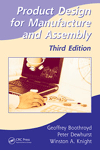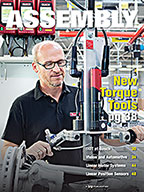When the Hubble Space Telescope turns its solar panels to the sun, it uses the same motion control technology that enables a six-axis robot to perform a series of spot welds quickly, accurately and repeatably.
That's because the robot and the telescope share a common design problem: How to get high torque capacity, torsional stiffness and positioning accuracy out of a servomotor, without adding a lot of weight or taking up too much space. For both applications, that problem was solved with harmonic-drive gear systems.
A harmonic drive consists of three components: a flexspline, a circular spline and a wave generator.
The flexspline is a thin-walled steel cup. The walls of the cup are radially compliant, but torsionally stiff, because the cup has a large diameter. Gear teeth are machined into the outer surface, near the open end of the cup. The flexspline is the output member of the mechanism. A rigid boss at one end provides a secure mounting surface.
The circular spline is a rigid steel ring with teeth on the inside diameter. It is attached to the housing and does not rotate.
The wave generator is an elliptical ball bearing assembly. It's usually attached to a servomotor and functions as the system's input. When the wave generator is inserted into the flexspline, the external teeth of the flexspline engage with the internal teeth of the circular spline at two spots: the opposite ends of the major diameter of the ellipse.
The flexspline has two less teeth than the circular spline. Every time the wave generator rotates one revolution, the flexspline and circular spline shift by two teeth. The gear ratio of the mechanism is the number of teeth on the flexspline divided by -2 (the number of teeth on the circular spline minus the number of teeth on the flexspline). Thus, if the flexspline has 200 teeth, the gear ratio will be -(100-to-1). The negative sign indicates that the input and output rotate in opposite directions.
Although the flexspline bends during operation, fatigue failure is not an issue. Operational stresses are far below the endurance limit of the material. The operating life of the drive is based on the life of the bearings in the wave generator. Gear tooth life will exceed bearing life, as long as the gear set is correctly mounted and lubricated, and torque and speed limits are not exceeded.
Harmonic drives produce little or no backlash, even after thousands of hours of operation. This is because 10 percent to 30 percent of the gear teeth are engaged at all times. So, for a system with a 100-to-1 gear ratio, 20 to 60 teeth are always engaged. In contrast, perhaps six teeth are always engaged in a planetary gear system, and only one or two teeth are engaged in a spur gear system. In addition, both sides of each tooth flank are engaged. Because backlash is defined as the difference between the tooth space and tooth width, this difference is zero for harmonic drives.
Harmonic drives provide high reduction ratios and good torque-to-weight ratios. Single-stage reduction ratios range from 50-to-1 to 320-to-1. Using compound drives, much higher reduction ratios can be achieved. At 2,000 rpm, some harmonic drives can produce a maximum output torque ranging from 5 to 950 newton-meters.
Harmonic drives are also highly efficient and accurate. A positional accuracy of ±30 arc-seconds is achievable with some models. Measured on actual shaft-to-shaft losses rather than tooth losses, standard gearing efficiencies range from 80 percent to 90 percent.
These characteristics make harmonic drives ideal for robotics. Hollow shaft harmonic drives allow wiring and air lines to connect with end effectors through the center of the gear, which saves space. Harmonic drives are also used in indexing tables, printing and converting machinery, medical imaging equipment, and semiconductor fabrication equipment.
For more information about harmonic drive gear systems, contact Harmonic Drive Technologies (Peabody, MA) at 800-921-3332 or www.harmonic-drive.com, or HD Systems Inc. (Hauppauge, NY) at 631-231-6630 or www.hdsystemsinc.com.



